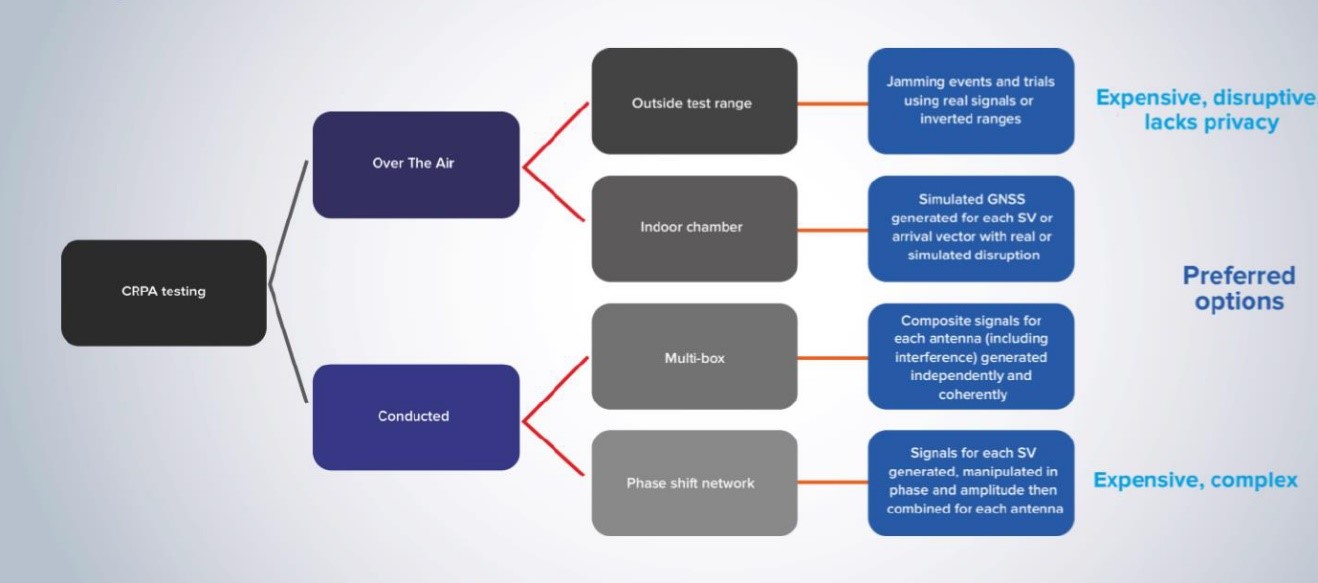

December 6, 2020
Guy Buesnel

NOTE: This blog is a summary of a webinar presented with DLR on Wednesday 18th November 2020. You can access the on-demand webinar here.
The GNSS threat landscape is evolving, and sophisticated new techniques are needed to protect GNSS-reliant equipment against RF threat sources such as jamming and spoofing.
One such technique is adaptive antenna technology. It has long been in use in the military domain, but is now starting to be considered for use in safety-critical civilian systems, as well as in some commercial applications.
Adaptive antenna systems can provide very effective protection against high levels of in-band Radio Frequency Interference (RFI), and some limited protection against spoofing attacks. However, they are complex in terms of design, expensive to develop, and challenging to test effectively.
This blog reviews some of the drivers and challenges involved, and provides some high-level recommendations around testing adaptive antennas. If you’d like to explore the topic in more depth, download our recent white paper: Characterizing an Adaptive Antenna.
The need for sophisticated adaptive antennas is being driven by two macro forces. One is the increasing reliance of the world as a whole on GNSS technology. Satellite-based positioning, navigation and timing (PNT) now play an essential role in many areas of critical national infrastructure, from cellular networks and energy grids to aviation, shipping and rail transport.
At the same time, manmade threats to GNSS signals are increasing in prevalence, adding to existing natural threats like ionospheric scintillation, obscuration and multipath effects.
GNSS signal jamming is now extremely common, whether it’s short-range jamming from personal privacy devices (PPDs) used to block GPS tracking of company vehicles, or powerful jamming used by nation states to disrupt enemy operations in conflict zones, which can affect civilian receivers over a very wide geographical range.
In 2019, for example, the aviation organization EUROCONTROL received an unprecedented 3,500 reports from pilots of GPS outages in the Eastern Mediterranean region, attributed to the various conflicts taking place in Syria, Libya and Azerbaijan.
GNSS spoofing (illicit broadcasting of fake or delayed GNSS signals) is on the rise, too – often occurring in targeted hotspots and affecting all unprotected receivers in the area. In 2019, for instance, mysterious ‘circle spoofing’ attacks occurred in parts of Shanghai and Tehran, causing ships and fitness trackers to appear to be moving in a circle.
It’s clear that safety-critical and liability-critical GNSS receivers need to be protected against such threats – and one proven approach is the use of adaptive antenna systems.
These systems come in various forms and varying degrees of sophistication, but the basic principle is that they work to reject interfering signals. This can be done either by physically blocking them (using a choke ring, for example) or by detecting the presence of interference signals and adjusting the antenna’s reception pattern to minimize or eliminate their impact.
The latter type, called a Controlled Reception (or Radiation) Pattern Antenna (CRPA), comprises multiple antenna elements that can be controlled individually. Algorithms detect interference signals and direct antenna elements to form a null in the direction of the interference source (known as null steering), or to direct gain towards genuine signals (known as beamforming).
There are many ways to design a CRPA. Some highly sophisticated and classified designs exist in the military domain, which provide very effective protection against jamming in high-interference environments. In our recent webinar, Andriy Konovaltsev of the German Institute of Communications and Navigation (DLR) presented the design of DLR’s prototype GALANT receiver, which uses an adaptive four-element antenna with beamforming algorithms.
As adaptive antennas are mission-critical, thorough testing is essential, but it can present many challenges. GNSS receivers with adaptive antennas are complex systems, and designing a test regimen requires a system-of-systems approach to ensure that every element is tested both in isolation and as a whole functioning system.
Evaluating the performance of the physical antenna is particularly challenging, because it requires GNSS, interference and (if required) spoofing signals all to be transmitted over the air.
That can be done on an outdoor test range, but obtaining permits to generate over-the-air interference or spoofing signals can be difficult and time-consuming, and the logistics of getting all of the necessary equipment to the test range can be quite daunting.
There are also the other perennial drawbacks of real-world testing: the signal environment is not repeatable, many of its elements are not controllable, the environment is limited to the satellites in view at the test location, and so on.

Simulation addresses many of these issues, and can be used to create highly representative signal environments in a lab (for conducted testing) or sealed chamber (for over the air testing).
Using simulation in place of field testing wherever possible not only brings down the cost of adaptive antenna testing, but can also help to bring new systems to market faster, as test timescales can be accelerated.
Spirent has worked with many designers and developers of CRPA systems to design advanced simulation solutions that specifically address the unique challenges of testing adaptive antenna systems, covering both conducted and over the air testing.
We can provide GNSS and interference signal simulation solutions for every stage in the CRPA design and verification process, including:
For full system testing, we have developed a unique and patented zoned chamber solution, which enables satellite motion to be emulated using multiple GNSS signal simulators in a sealed chamber – allowing for more realistic testing and longer test scenario durations.
Our professional services team is also well versed in implementing and advising on CRPA test environments and would be happy to discuss any aspect of your CRPA or adaptive antenna testing challenges.
If you would like to find out more about Spirent solutions for adaptive GNSS antenna testing, you can download the whitepaper, watch the webinar, or contact us directly.